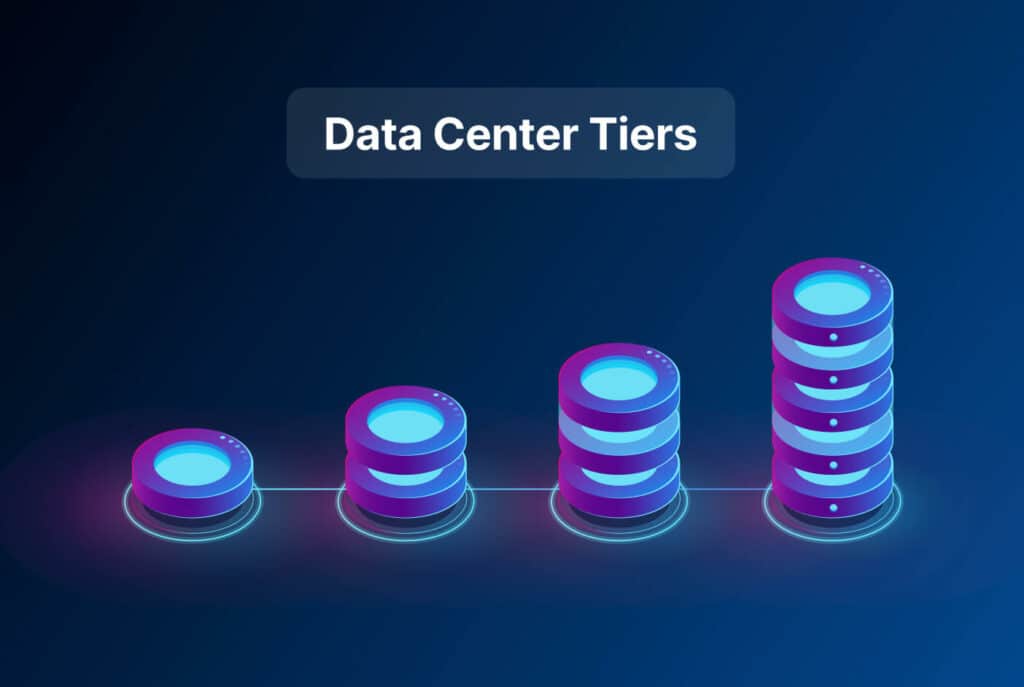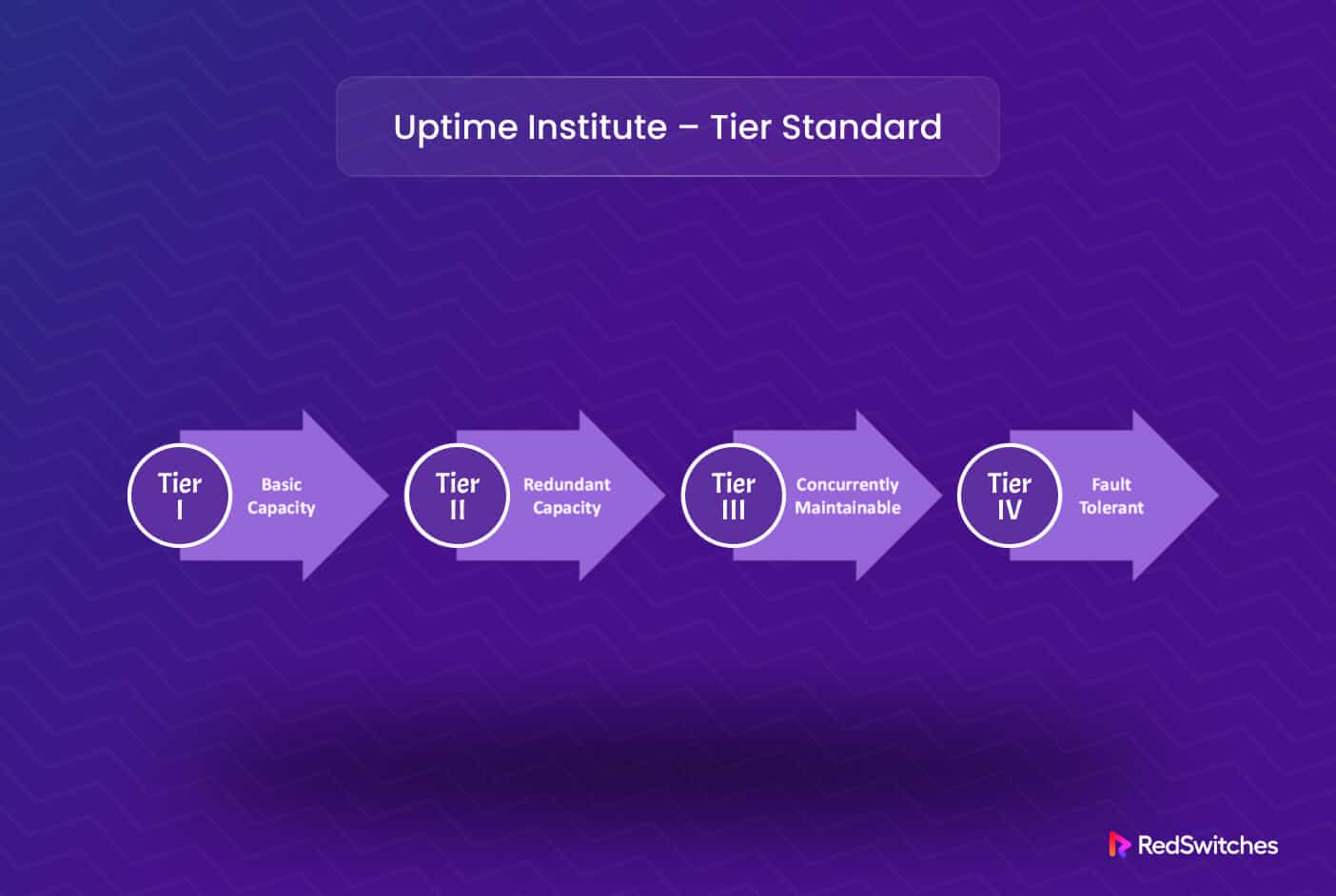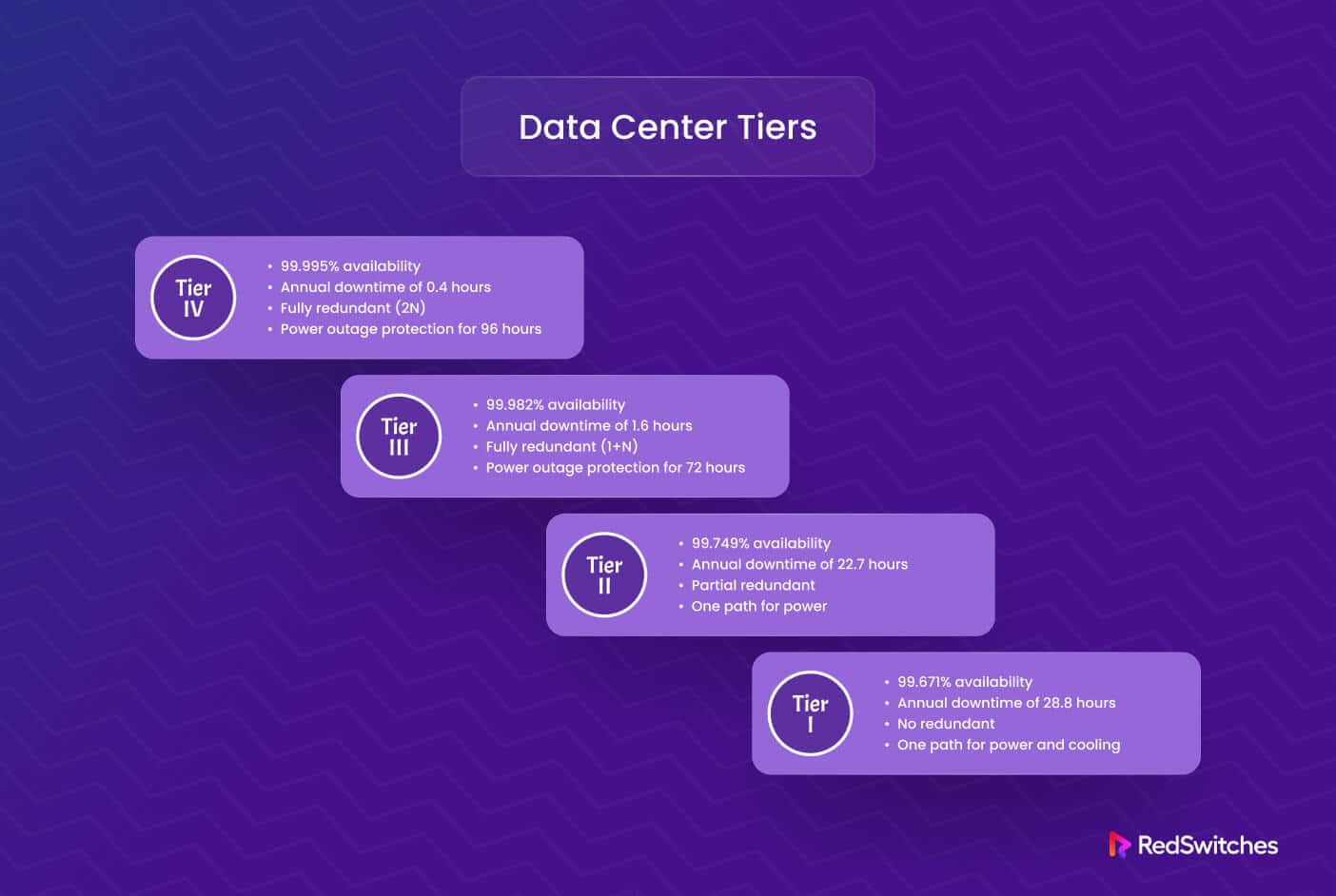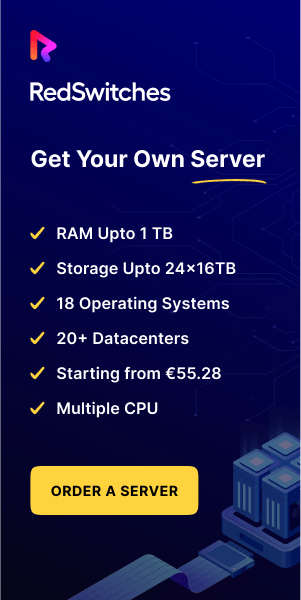Have you ever wondered what makes a data center different from another?
The answer lies in the idea of data center tiers.
Businesses should understand how data tiers work to invest in proper resources to build the data center that conforms to their required tier designation.
Data centers play a vital role in our increasingly connected world. They house the critical infrastructure that supports the storing and processing of vast data volumes. However, not all data centers are created equal. Data center tiers are a standardized classification system that categorizes these facilities’ quality, reliability, and uptime.
In this article, we will explore the concept of data center tiers, their significance, and how they impact the reliability and availability of your critical business operations. By gaining a deeper understanding of data center tiers, you can ensure that your digital infrastructure is built on a solid foundation, maximizing efficiency and minimizing potential risks.
Let’s start with the definition of data center tiers.
Table Of Contents
- What Are Data Center Tiers?
- The Essential Factors in Data Center Tier Classification
- How Do Data Centers Obtain a Tier Rating?
- Understanding the Key Factors in Data Center Tier Comparison
- Which Data Center Tier is Right for You?
- Key Takeaways
- FAQs
What Are Data Center Tiers?
Data center tiers are standardized system classifications that categorize and rank data centers based on their infrastructure components, reliability, and redundancy capabilities. The tiers range from Tier I to Tier IV, based on data center redundancy levels, uptime guarantee, staff expertise, and maintenance protocols.
Before starting in details you can also read about the data center engineers daily life routine now Let’s discuss these data center tier ratings in detail:
Tier I Data Center
Tier I data centers provide the most basic infrastructure capabilities.
They have a single distribution path for power and cooling, with no redundancy or backup systems. As a result, tier I data centers are prone to frequent and more extended downtime periods.
Tier I data centers are an excellent fit for hosting non-critical applications and SMB operations where uptime is not a mission-critical requirement.
A data center has to meet the following requirements to be classified as a Tier I data center:
- The data center should have a designated area for ICT systems.
- The primary power is supplemented with an uninterruptible power supply (UPS).
- The dedicated HVAC system operates beyond business hours.
- The data center has a power generator for extended power outages.
Generally speaking, Tier 1 data centers have a basic infrastructure, so they’re used mainly by hosting providers for shared hosting solutions. These data centers typically offer few (if any) redundancy options. In most cases, these data centers aren’t used for critical operations because of the lack of backup options.
You should also keep in mind that Tier 1 data centers have to completely shut down for repairs and maintenance to prevent system failure. During this outage, all business operations could go offline and become unavailable to the users.
Tier II Data Center
Tier II data centers are built on a Tier I foundation that is extended by adding a layer of redundancy and backup systems.
These data centers incorporate redundant power and cooling components, allowing for scheduled maintenance without disrupting operations. Tier II data centers offer higher availability than Tier I but may not have the reliability required for mission-critical applications.
The strength of Tier II data centers lies in the redundancy options added to Tier I infrastructure. These options include:
- Additional power generators.
- Additional HVAC and environment protection.
- Chillers to maintain equipment temperature.
- UPS modules.
- Raised floors.
- Energy storage options.
- Heat transfer equipment
- Fuel tanks and cells.
Although Tier II data centers lack many features that Tier III and Tier IV data centers offer, they are a more robust, secure, and reliable option than Tier I data centers. However, we strongly advise against deploying critical processes on Tier II data centers of the uptime issues.
Tier III Data Center
Tier III data centers are designed for businesses with higher uptime requirements.
The distinguishing feature of these data centers is the redundant distribution paths for power and HVAC distribution, providing high redundancy and reliability.
The data center team can carry out maintenance and repairs without disrupting ongoing operations. Tier III data centers typically offer a 99.982% uptime guarantee, making them suitable for most organizations that rely on the continuous availability of business operations.
In addition to all of the features of a Tier II data center, a Tier III data center must have:
- An N+1 redundancy, where “N” refers to the capacity needed to support the entire data center capacity. This results in a 100% redundancy in power and supporting features.
- A dedicated power backup component that ensures the data center operates during local and regional power outages.
- The capacity to operate for a minimum of 72 hours on an internal power supply during a power outage.
Note that while Tier III data centers offer superior redundancy compared to the first two tiers, they aren’t fully redundant, and external factors can still affect internal operations.
Tier IV Data Center
Tier IV data centers provide reliable, redundant infrastructure for critical business operations.
These data centers build upon Tier III data center features and add additional fault tolerance measures. Tier IV data centers have multiple isolated systems and active power and cooling paths. This configuration practically eliminates single point(s) of failure. Consequently, these data centers offer the highest level of availability, with an uptime guarantee of 99.995% during unplanned or planned maintenance.
Enterprises, financial institutions, and large SaaS and ICT products primarily use Tier IV data centers to ensure uninterrupted access to critical applications, regardless of external factors such as power outages.
A data center has to fulfill all the requirements of the above tiers and provide the following additional capabilities before it can be classified as a Tier IV infrastructure.
- All distribution pathways are independent.
- The data center can operate on internal power for at least 96 hours during a local or region-wide power outage.
- All components are supported by at least two cooling systems, UPS modules, and power generators.
- The data center must have an independent power supply that is not connected to any external sources.
Generally, a tier IV data center must either have a 2N or 2N+1 redundancy capacity.
A 2N redundancy model means the data center has an independent system on standby. If the primary system goes offline, an identical backup copy takes over the operations.
A 2N+1 redundancy model, on the other hand, offers double operational capacity and an additional backup component. The backup component takes over data center operations if the secondary system fails.
As such, Tier IV data centers offer uninterrupted availability and fault tolerance, making them the best option for businesses that must ensure sustained service delivery with no outages and lags.
It is important to note that achieving each tier requires strict adherence to specific design and operational criteria defined by industry standards, such as the Uptime Institute’s Tier Classification System.
The Essential Factors in Data Center Tier Classification
The Uptime Institute introduced a data center tier classification system that has become the globally recognized data center design and operations authority.
The Institute’s classification system consists of four tiers: Tier I being the least reliable and Tier IV being the most reliable. The tier certification level is based on criteria that evaluate a facility’s infrastructure components, availability, and redundancy capacity.
Discuss this standard’s six evaluation criteria for classifying data center facilities.
Redundancy in Electrical Systems
Electrical system redundancy is a primary factor in data center tier classification. The availability of backup power sources such as generators and UPS systems measures this redundancy factor. Higher-tier data centers have redundant power systems to ensure uninterrupted operation, even in the event of a power outage.
Redundancy in HVAC (Cooling) Systems
Data centers generate significant heat due to the high density of server machines and networking equipment.
Efficient cooling-focused HVAC systems are vital to maintaining optimal conditions for the continuous operation of servers and data center infrastructure. Higher-tier data centers have redundant cooling systems to ensure the internal temperature is suitable for servers and network devices. This is a critical data center operational requirement because heat can damage physical components and affect operations.
Concurrent Maintainability
Data centers must perform routine maintenance and upgrades without disrupting the ongoing operations. The concept of concurrent maintainability states that the data center teams can service and replace infrastructure components without impacting critical systems. Higher-tier data centers are designed with redundant paths and components for concurrent maintenance. A secondary backup component can support hosted processes if a primary component goes offline during maintenance.
Fault Tolerance
Data centers with higher tier designation have a high fault-tolerant design that minimizes the impact of component failures. This involves redundant servers, storage systems, firewalls, power & HVAC, and networking equipment. In case of a component failure, the workload can be seamlessly shifted to the redundant components, preventing downtime or data loss.
Physical Security
Physical security measures are the most overlooked aspect of data center classification standards. This highly crucial protective measures include 24/7 surveillance systems, access control, biometric authentication, and secure perimeter fencing. Higher-tier data centers have very stringent security measures to protect the building and infrastructure components from theft and physical damage.
Connectivity
Data centers need reliable, high-speed connectivity for seamless data transfer and access. Higher-tier data centers are typically located in areas with robust internet infrastructure, multiple carriers, and diverse network paths to provide uninterrupted connectivity. In addition, these data centers implement multiple connectivity methods, including hardlines, cellular, and wireless connections, for redundant connectivity.
It is important to note that data center tier classification is not a measure of the quality or performance of the services provided by a data center. Instead, it indicates the robustness and reliability of the data center infrastructure.
How Do Data Centers Obtain a Tier Rating?
After going through the data center tier classification criteria, the next critical question is how is a data center rated and assigned a tier.
To obtain a tier rating, a data center must undergo an audit process that evaluates it on a list of factors, including the availability, capacity, resilience, security, and maintainability of the infrastructure and services.
The Uptime Institute provides appropriate documentation for this audit process and assigns a tier rating based on the data center’s infrastructure score.
The Uptime Institute’s tier rating system is designed to ensure that data centers are held to the highest standards of reliability and performance. Additionally, it is also important for data centers to maintain a high level of operational efficiency. In order to achieve a good score in this regard, they must optimize their infrastructure design and services in accordance with industry best practices. Additionally, data centers can remain competitive and reliable by utilizing technologies such as virtualization, cloud computing, and storage optimization.
Understanding the Key Factors in Data Center Tier Comparison
When it comes to data centers, not all facilities are created equal.
Different data center tiers offer varying reliability, redundancy, and performance levels. Understanding the differences between the tiers is crucial for businesses relying on data center capabilities to deliver service to their global clientele.
Let’s explore the main factors differentiating data center tiers and why businesses should evaluate when shortlisting data centers for hosting their operations.
Uptime Guarantee
Uptime guarantee is the most fundamental factor companies consider when choosing a data center tier. Uptime refers to the time a data center is operational without any service interruption. Tier I data centers have the lowest uptime guarantee, while Tier IV data centers offer the highest uptime guarantee.
Here’s how data center tiers compare by their uptime:
Tier I data center – Typical uptime 99.671%, estimated maximum annual downtime: 28.8 hours
Tier II data center – Typical uptime 99.749%, estimated maximum annual downtime: 22.7 hours
Tier III data center – Typical uptime 99.982%, estimated maximum annual downtime: 1.6 hours
Tier IV data center – Typical uptime 99.995%, estimated maximum annual downtime: 26.3 minutes
Downtime per Year
Downtime refers to the amount of time a data center is non-operational.
Tier I data centers can experience up to 28.8 hours of downtime per year, while Tier IV data centers have a maximum allowable downtime of just 26.3 minutes per year.
Businesses should factor in the costs associated with the data center’s efforts to minimize downtime. This means that a Tier IV data center is costlier because of the low downtime.
Component Redundancy
Component redundancy refers to the backup systems that ensure uninterrupted operations in the event of a failure.
Higher-tier data centers have multiple redundant systems, especially backup power, cooling, and network connections. Tier IV data centers offer the highest level of redundancy, with no single point of failure.
Concurrently Maintainable
Concurrently maintainable refers to a data center’s ability to perform regular maintenance and upgrades without interrupting active operations.
This critical functionality ensures service delivery continuity and hosted business process availability.
Tier IV data centers are designed to allow maintenance work to be carried out without impacting the facility’s uptime. This is a direct benefit of the redundancy built into the data center design that emphasizes setting up multiple components within subsystems.
Price
Naturally, the costs of working with data centers increase as you go up the tier system, and higher-tier facilities with greater reliability and redundancy come with a higher price tag. However, companies must assess their needs and weigh the cost against the potential risks and downtime they could tolerate.
Compartmentalization
Compartmentalization refers to the physical segregation of critical infrastructure components to enhance system resilience. Higher-tier data centers have better compartmentalization, separating essential infrastructure elements to minimize the impact of an outage or failure.
Staff Expertise
Higher-tier data centers tend to have more skilled and qualified staff members with expertise in maintaining and troubleshooting complex systems. Most Tier IV data centers have 24/7 on-site staff, ensuring efficient response times in case of emergencies.
Typical Customer Profile
Different data center tiers attract different types of customers.
Generally, Tier I and Tier II data centers are suitable for small to medium-sized businesses. At the same time, large enterprises, government agencies, and organizations with critical infrastructure requirements more commonly use Tier III and Tier IV data centers.
Businesses choose a particular data center tier based on their specific needs. For instance, small businesses may prioritize cost-effectiveness and reliability, making Tier I or II data centers a suitable fit. On the other hand, large corporations with high-value operations or business demands may prioritize maximum uptime and redundancy, leading them to select Tier IV data centers.
Which Data Center Tier is Right for You?
When deciding which data center tier is right for you, it’s crucial to consider your business needs, budget, and tolerance for downtime. Smaller businesses with limited resources may opt for Tier I or Tier II data centers, while larger enterprises with mission-critical operations may prefer Tier III or Tier IV data centers.
Additionally, it’s essential to consider future scalability and growth. If your business is expected to expand rapidly, it may be wise to choose a higher-tier data center to ensure it can accommodate your needs in the long term.
Key Takeaways
- Data center tiers are used to classify data centers by their reliability, quality, uptime, and overall performance.
- The Uptime Institute standards define four data center tiers.
- Tier I defines a basic data center infrastructure and has the lowest performance output.’
- Tier II defines a data center with a single power input and a single pathway for cooling systems. These don’t offer protection against unexpected disruptions.
- Tier III data centers offer superior redundancy to Tier I and II but aren’t fully safe from external disruptions.
- Tier IV classifies data centers with the best performance and can function continuously without interruption.
Looking for Affordable Dedicated Servers? Check out RedSwitches – a Colocation Provider.
Whether you need bare metal server or fully managed dedicated servers or move servers from on-site to a colocation center, RedSwitches has a hosting solution for you! We offer fully customizable dedicated servers with affordable pricing and top-tier data center performance.
Our servers are located in Tier 3 data centers in 20+ locations worldwide. Choose your preferred hosting location to host your websites and web apps closer to your users.
Our hosting options use the latest hardware, ensuring lightning speeds and high reliability. You can choose between several hosting plans that fit your website type and, most importantly, your budget.
Contact us today to discuss the optimal hosting solution for your business!
FAQs
#1. What is a data center tier rating?
Data centers are essential to the modern business world. Organizations rely on them for various reasons, from storing and backing up data to hosting websites and applications. Fortunately, businesses have many options for selecting the right data center.
When choosing a data center tiering system, organizations must consider budget, scalability, downtime, security, and redundancy factors. A data center tier rating is an industry-standard classification system used to rate data centers’ reliability, quality, and performance. It has four tiers: Tier I, II, III, and IV.
#2. What tier is Google Cloud?
Google Cloud offers its customers a Tier IV data center rating, making it one of the best options for mission-critical operations. This tier is the most reliable and offers the highest performance out of all the tiers, ensuring superior redundancy and uptime.
#3. Are Azure data centers Tier IV?
Microsoft Azure data centers are rated at Tier IV, ensuring they provide users with superior uptime and redundancy.
#4. What is a Tier 0 data center?
A Tier 0 data center is a single-site data center that doesn’t offer data backup services.
#5. Can a data center be destroyed?
Yes, in cases of extreme disasters like floods, fires, or natural disasters, data centers can be fully destroyed. However, a Tier III or IV data center will keep off-site backups of your data.
#6. Who sets the standard for data center tiers?
The Uptime Institute sets the standard for data center tiers. This organization was founded in 1993 and focuses on providing services that help improve the reliability of computer networks. The institute developed a classification system known as the Tier Standard, which rates data centers according to their redundancy, reliability, and performance. The four tiers range from Tier I, which is the least reliable and has the lowest performance, to Tier IV, which is the most reliable and offers the best performance.



